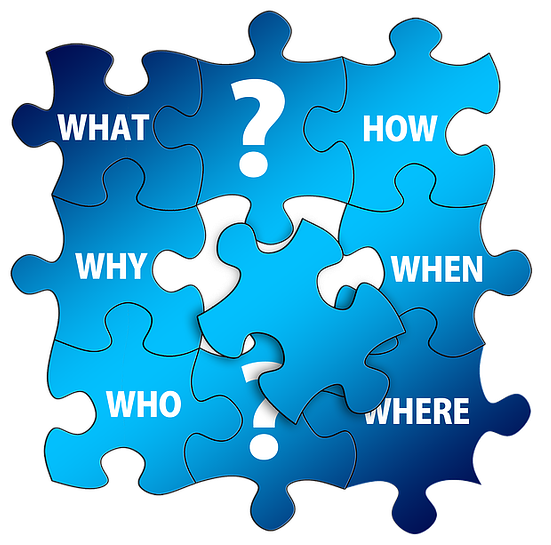ANSWER
Overview of the 5 W Questions
The term “5 W questions” refers to the five basic questions commonly asked when gathering information. These interrogative words are also known as the 5 W and 1 H.
Without further ado, here are the 5 W questions plus one H::
-
Who
-
What
-
When
-
Where
-
Why
-
How
These questions are not to be used mindlessly but are very useful to get you started in your interviewing sessions and in requirements gathering.
When you are stuck and can’t figure out where to start, the 5 W questions provide one of the best frameworks to help you ask the right questions.

Origin of the 5 W Questions
The Five Ws and How questions have been used since antiquity and are attributed to Aristotle, being the source of the six elements of circumstance: Quis, quid, quando, ubi, cur, quem ad modum, quibus adminiculis. These are translated as: who, what, when, where, why, in what way, by what means.
“For in acts we must take note of who did it, by what aids or instruments he did it (with), what he did, where he did it, why he did it, how and when he did it.” - Thomas Aquinas
These questions have long been used to establish the facts around a given circumstance be it by a journalist or in a legal setting. Their usefulness comes not just from the completeness of interrogation but also because they cannot be answered with a simple “yes” or “no”.
Let’s see next how we can use use and apply the 5 W questions plus the H to our analysis craft.
How to Use the 5 W Questions
| # |
5 W and 1 H
|
Focus
|
Examples Questions
|
|
1
|
WHO
|
With this interrogative question, the focus is put on people who are in one way or another stakeholders of the project.
|
Who are the subject matter experts?
Who is sponsoring this project?
Who will be the users of the system?
Who will be negatively impacted if this project fails?
Who are the actors involved in this process?
|
|
2
|
WHAT
|
The what question is really the first question to ask on the project focusing as well as helps clarify details around the who.
|
What is the problem we are trying to solve?
What do you want to accomplish with this project?
What is the product vision?
What are the needs of the key stakeholders?
What tools are needed by the systems users?
What do the actors do in context of the process?
|
|
3
|
WHEN
|
Next we move the focus to the temporal aspect by using the when interrogative to identify the relative or specific point in time when activities need to take place.
|
When does the project need to be delivered?
When in the process lifecycle does a given activity need to occur?
When should a given document be generated?
|
|
4
|
WHERE
|
From the temporal we move to the location where an activity is or will need to take place. While this question may seem unimportant it will help uncover key details if you are thinking out of the box.
|
Where are the users of the system located?
Where are the data centers?
Where will the code be deployed?
Where should we start our project?
Where is the team working on the project located?
|
|
5
|
WHY
|
This may possibly be the most important interrogative getting to the heart of the matter aka the motivation behind the project aka the why. It can also be used to clarify responses from the rest of the questions.
|
Why is this a problem?
Why do you think this is going to increase revenue?
Why is this actor needed?
Why is a given activity performed?
Why is the batch process run hourly?
Why are the users located in a given location?
|
|
6
|
HOW
|
The How question can be used to clarify previous answers. It is also helpful to understand how project stakeholders might envision the solution.
|
How do you envision the solution would work?
How will users use the system?
How many concurrent users need to be supported?
How often should a given activity be performed?
|
The above example questions do not constitute an exhaustive list but it’s just a start to get you thinking about how you might use the 5 W Questions and the 1 H.
Your turn:
-
Who do you think should use the 5 W Questions + 1 H?
-
What is the impact of using the 5 W Questions + 1 H?
-
When in the project lifecycle would you use the 5 W Questions + 1 H?
-
Where would you document the answers to the 5 W Questions + 1 H?
-
Why do you think the 5 W Questions + 1 H are (or are not) useful?
-
How would you use the 5 W Questions + 1 H?